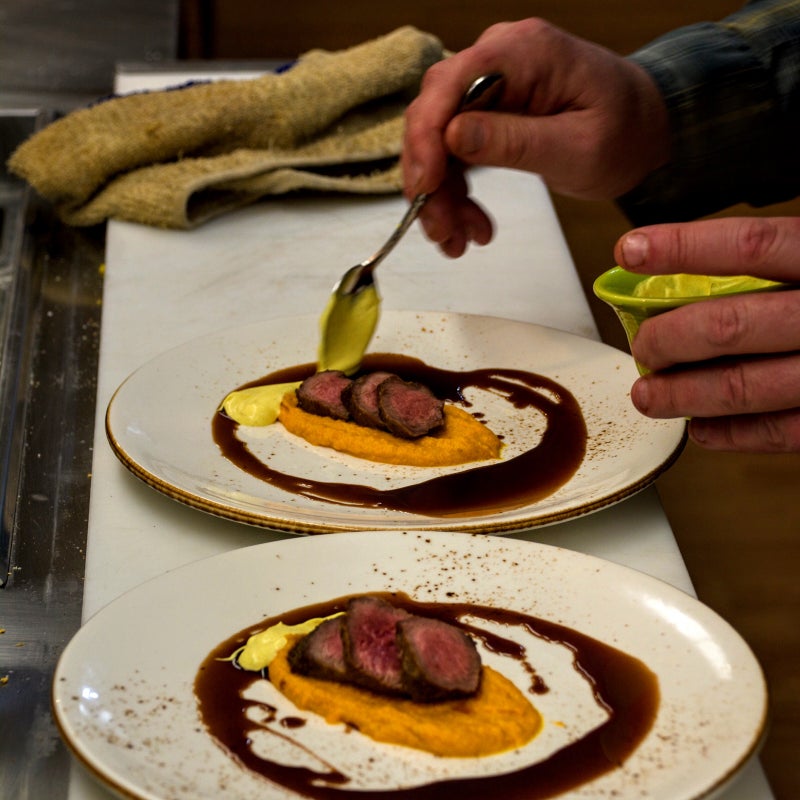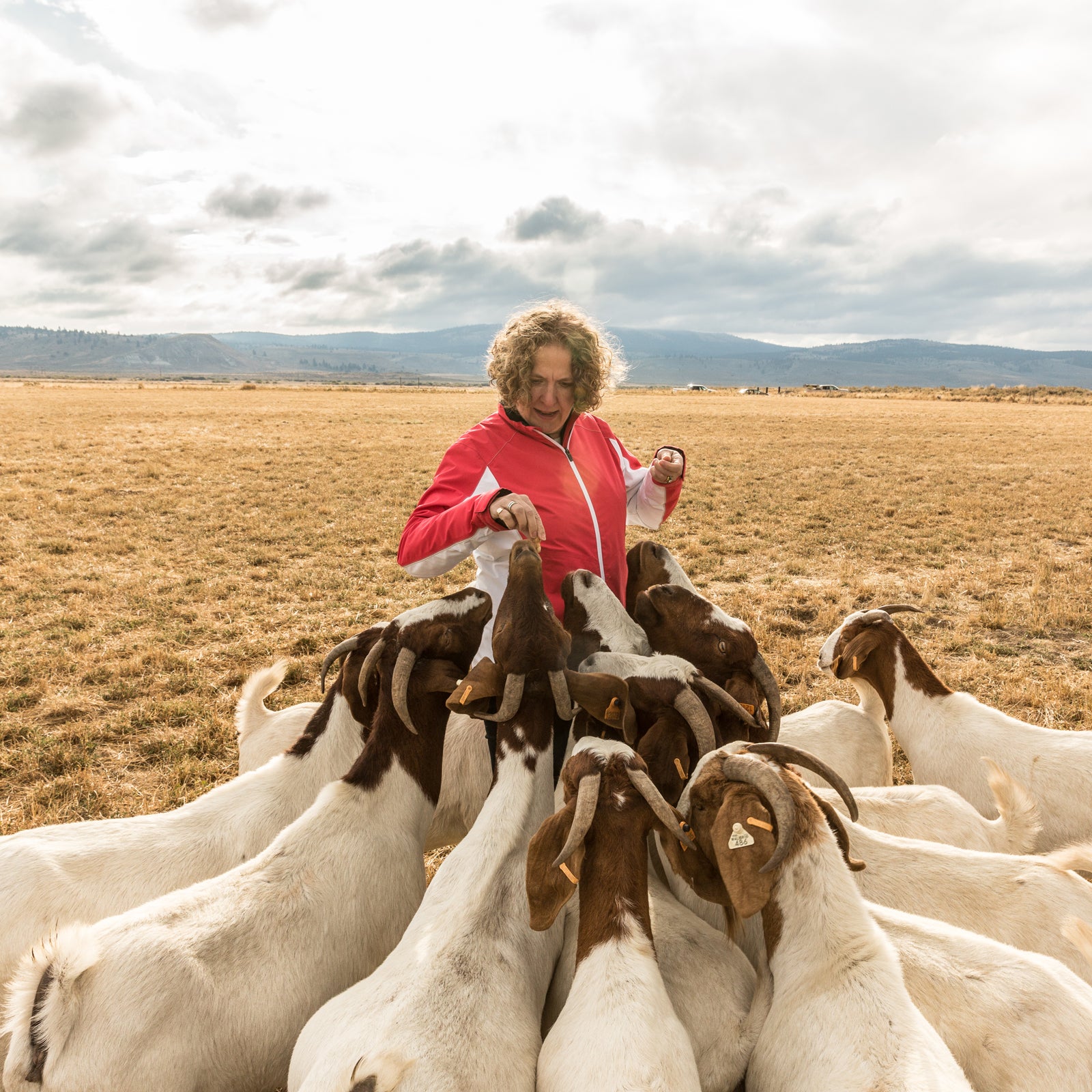When an abandoned billy goat showed up on BLM land in New Castle, Colorado, Sylvia Ringer, a wildlife biologist for the federal agency, figured he could stay with her while they looked for his owner. No one came forward.
“You can’t just have one,” she says. So Ringer, who lives on a hobby ranch and has plenty of room, got the billy a female friend. “And they just started multiplying.”
After a summer drought left Ringer with less hay than her goats and donkeys would require for winter, she and her family realized there was a solution to their problem: “We were like, well, let’s eat a goat.” Ringer and her husband had never eaten goat meat, though, and didn’t know the first thing about butchering or cooking it. Luckily, a friend in her town of Rifle, Colorado, who is originally from South Sudan, volunteered his expertise.
Goat meat is eaten all over the planet, particularly in Africa, China, the Middle East, and the Caribbean. However, the oft-repeated claim that is likely not true. Still, “Americans are missing out,” says Mayom Achuk, the friend that helped Ringer butcher her first goat. Achuk raised goats in South Sudan as a boy, before rebels arrived in his village in 1983 and killed his entire herd. Now Achuk laments how hard it is to find goat meat in America.
From a nutritional perspective, goat—which most U.S. restaurants call chevon—has almost no saturated fat and considerably fewer calories and fat than beef, with just as much protein. It also has more iron.
Of course, it’s not accurate to say Americans don’t eat goat meat. Many immigrant populations specifically seek it out—even when it’s tough to find. But while the rest of America increasingly eats goat cheese, they’re behind the curve on its meat. And that’s a shame, because goat meat is better for the planet and healthier for our bodies than beef.
From a , goat—which most U.S. restaurants call chevon (after ����è������, the French word for goat)—has almost no saturated fat and considerably fewer calories and fat than beef, with just as much protein. It also has more iron. Nutritionally, it’s more or less on par with chicken, but it tastes more like red meat.
“We love to introduce people to chevon,” says Damon Jones, executive chef at , the fine-dining restaurant at Silvies Valley Ranch, a working ranch and retreat in eastern Oregon. “It’s a very sweet, succulent meat.” Silvies raises goats with its cattle, and Jones says some guests make faces when they see goat on the menu. “Once I get them to try it, they’re blown away by it,” he says. Jones is slowly converting his chef friends, too, and Silvies is now delivering fresh goat meat to some of the Pacific Northwest’s best restaurants.
A few years ago, I spotted chevon on a menu in Seattle and, out of curiosity, ordered it. I still think about that dish. Goat meat tastes like a sweeter, less gamey version of lamb. When cooked right, it’s as tender as a filet.
Meanwhile, environmentally, “Goats don’t cause as much erosion, and they don’t excrete as much waste as cows do,” explains Anita Teel Dahnke, executive director of the . She transitioned her farm in Indiana to goats after realizing the erosion cattle were causing to her property. Even better, when managed properly, goats may actually help restore waterways, says Nicole Civita, the faculty lead in sustainable food systems at the University of Colorado in Boulder. Goats, unlike cows, don’t like hanging out in water. Instead of getting in and wallowing, they spend time at the edge of a stream, where their small hooves create dents for seeds to nestle into the ground, helping establish plant life. Because they don’t wallow, they don’t tend to add manure to streams. “This is a pretty big bonus,” Civita says.
Teel Dahnke adds that the nitrogen in goat poo doesn’t “burn” and suffocate the grass beneath it the way cattle excrement does. And Civita says that their “feces are in pellet form, which makes them easier to handle. Goat manure can be a great source of potassium, potash, and nitrogen,” which can be used to nourish soil in fields. “Goats can also be strategically ‘deployed’ to browse on brush that is not desired by humans or incompatible with our development strategies, such as invasive wild plants,” Civita says. In fact, in California, some towns are using goats to graze their way to .
Goats grow and multiply fast, as Ringer found out. Adult female goats (called does) almost always birth twins or triplets. They can produce milk (and thus goat cheese), too, though farmers usually use different breeds for milk and meat production. Cattle ranchers are beginning to mix goats in with their herds as natural weed controllers, eliminating the need to spray with products like Roundup. On, 3,000 goats browse down juniper next to its cattle herd. “Juniper is a very invasive tree species that harms watersheds and spreads wildfire, but the goats just love it,” says Colby Marshall, general manager for the ranch.

Goats do have some drawbacks. Like any animal, too many in an inadequate space can be destructive. On Redonda Island in the Caribbean, . They’re also ruminants, like cows, which means they ferment their food, creating greenhouse gas when emitting burps and farts. However, goats produce significantly less than cows. One study Civita is familiar with says goats emit just of cattle.
But there are some logistical problems in raising goats for meat. One is that there still aren’t that many farmers doing it. Teel Dahnke says that half the goat meat eaten in the U.S. is imported, , which means finding a slaughterhouse that works with goats is difficult. That’s unlikely to change anytime soon. Goat-meat production hasn’t actually grown much in the U.S. in recent years. According to a goat-industry update from June 2018, which ran in Goat Rancher Magazine, slaughter numbers were up in 2018 but were still lower than the number of goats produced for meat ten years ago.
Also, goats are nearly impossible to keep contained. “The adage with raising goats is: if it won’t hold water, it won’t hold a goat,” says Silvies Valley’s Marshall. And finally, the animals tend to push their way into owners’ hearts, turning them from livestock to pets in no time. “Goats are social with people the way dogs are,” says Teel Dahnke. In fact, at Silvies, two goats (named Bruce and Mike) act as caddies, ferrying golf clubs around and making guests smile. “The guests adore them,” Jones says. “They’re very gregarious animals. They want to see what’s going on. They’re very friendly.”
Ringer found this out the hard way. On the day they’d set to slaughter their first goat, two of her kids were beside themselves. “We eat meat, and we tried to explain to them that a lot of animals don’t have a great life. But this goat had a great life and then one bad day,” she said. There were a few tears, but after the goat was quartered, marinated, and roasted over a fire, there were no regrets. “It was amazing. Like a fine steak,” says Ringer. They served it at a Christmas party, and “there was not a drop left,” Ringer says, adding, “My only thought was: Why aren’t more people eating this?”


